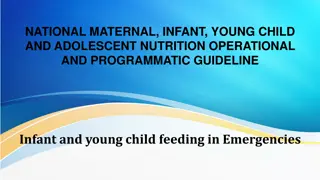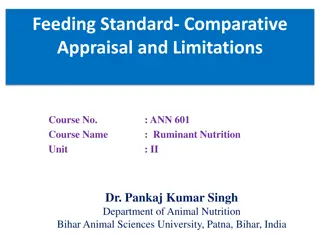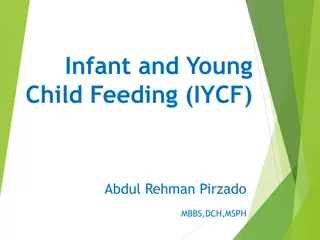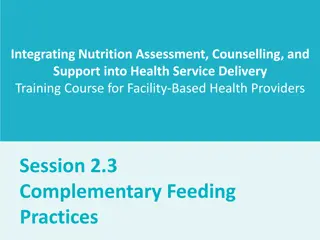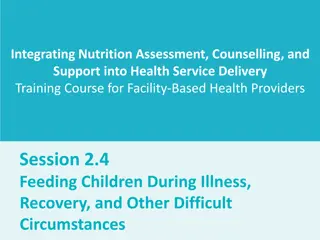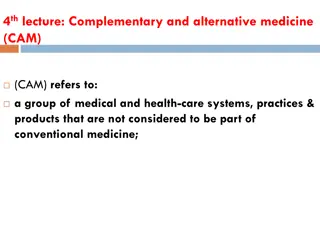Guidance for Complementary Feeding in Infants
After 6 months of age, breastfed infants may struggle to meet their nutrient needs from milk alone, necessitating the introduction of complementary foods. Implementing guiding principles can help ensure optimal nutrition and growth, including exclusive breastfeeding for the first 6 months, practicing responsive feeding, maintaining good hygiene, gradually introducing varied foods, and adjusting food consistency as the infant grows. Proper feeding practices, nutrient-rich foods, and timely supplementation are key to supporting healthy development during the complementary feeding period.
Download Presentation

Please find below an Image/Link to download the presentation.
The content on the website is provided AS IS for your information and personal use only. It may not be sold, licensed, or shared on other websites without obtaining consent from the author.If you encounter any issues during the download, it is possible that the publisher has removed the file from their server.
You are allowed to download the files provided on this website for personal or commercial use, subject to the condition that they are used lawfully. All files are the property of their respective owners.
The content on the website is provided AS IS for your information and personal use only. It may not be sold, licensed, or shared on other websites without obtaining consent from the author.
E N D
Presentation Transcript
Complementary Feeding Guiding Principles for Complementary Feeding After 6 months of age, it becomes increasingly difficult for breastfed infants to meet their nutrient needs from human milk alone. Furthermore most infants are developmentally ready for other foods at about 6 months. In settings where environmental sanitation is very poor, waiting until even later than 6 months to introduce complementary foods might reduce exposure to food-borne diseases. However, because infants are beginning to actively explore their environment at this age, they will be exposed to microbial contaminants through soil and objects even if they are not given complementary foods. Thus, 6 months is the recommended appropriate age at which to introduce complementary foods . During the period of complementary feeding, children are at high risk of undernutrition . Complementary foods are often of inadequate nutritional quality, or they are given too early or too late, in too small amounts, or not frequently enough. Premature cessation or low frequency of breastfeeding also contributes to insufficient nutrient and energy intake in infants beyond 6 months of age.
Guiding principles for complementary feeding of the breastfed child 1. Practice exclusive breastfeeding from birth to 6 months of age, and introduce complementary foods at 6 months of age (180 days) while continuing to breastfeed. 2. Continue frequent, on-demand breastfeeding until 2 years of age or beyond. 3. Practice responsive feeding. 4. Practice good hygiene and proper food handling. 5. Start at 6 months of age with small amounts of food and increase the quantity as the child gets older, while maintaining frequent breastfeeding. 6. Gradually increase food consistency and variety as the infant grows older, adapting to the infant's requirements and abilities. 7. Increase the number of times that the child is fed complementary foods as the child gets older. 8. Feed a variety of nutrient-rich foods to ensure that all nutrient needs are met. 9. Use fortified complementary foods or vitamin-mineral supplements for the infant, as needed 10. Increase fluid intake during illness, including more frequent breastfeeding, and encourage the child to eat soft, favourite foods. After illness, give food more often than usual and encourage the child to eat more.
1. Practice exclusive breastfeeding from birth to 6 months of age and introduce complementary foods at 6 months of age (180 days) while continuing to breastfeed Exclusive breastfeeding for 6 months confers several benefits to the infant and the mother. Chief among these is the protective effect against gastrointestinal infections, which is observed not only in developing but also in industrialized countries. According to the WHO growth standards, children who are exclusively breastfed have a more rapid growth in the first 6 months of life than other infants . By the age of 6 months, a baby has usually at least doubled his or her birth weight, and is becoming more active. Exclusive breastfeeding is no longer sufficient to meet all energy and nutrient needs by itself, and complementary foods should be introduced to make up the difference. At about 6 months of age, an infant is also developmentally ready for other foods. The digestive system is mature enough to digest the starch, protein and fat in a non-milk diet. Very young infants push foods out with their tongue, but by between 6 and 9 months infants can receive and hold semi-solid food in their mouths more easily.
2. Continue frequent on-demand breastfeeding until 2 years of age or beyond Breastfeeding should continue with complementary feeding up to 2 years of age or beyond, and it should be on demand, as often as the child wants. Breast milk continues to provide higher quality nutrients than complementary foods, and also protective factors. Breast milk can provide one half or more of a child's energy needs between 6 and 12 months of age, and one third of energy needs and other high quality nutrients between 12 and 24 months. Breast milk is a critical source of energy and nutrients during illness , and reduces mortality among children who are malnourished . In addition, breastfeeding reduces the risk of a number of acute and chronic diseases. Children tend to breastfeed less often when complementary foods are introduced, so breastfeeding needs to be actively encouraged to sustain breast-milk intake.
3. Practice responsive feeding Optimal complementary feeding depends not only on what is fed but also on how, when, where and by whom a child is fed. Behavioural studies have revealed that a casual style of feeding predominates in some populations. Young children are left to feed themselves, and encouragement to eat is rarely observed. In such settings, a more active style of feeding can improve dietary intake. The term responsive feeding is used to describe caregiving that applies the principles of psychosocial care. Responsive feeding Feed infants directly and assist older children when they feed themselves. Feed slowly and patiently, and encourage children to eat, but do not force them. If children refuse many foods, experiment with different food combinations, tastes, textures and methods of encouragement. Minimize distractions during meals if the child loses interest easily. Remember that feeding times are periods of learning and love talk to children during feeding, with eye-to-eye contact.
4. Practice good hygiene and proper food handling Microbial contamination of complementary foods is a major cause of diarrheal disease, which is particularly common in children 6 to 12 months old. Safe preparation and storage of complementary foods can prevent contamination and reduce the risk of diarrhea. The use of bottles with teats to feed liquids is more likely to result in transmission of infection than the use of cups, and should be avoided . All utensils, such as cups, bowls and spoons, used for an infant or young child's food should be washed thoroughly. Eating by hand is common in many cultures, and children may be given solid pieces of food to hold and chew on, sometimes called finger foods . It is important for both the caregiver's and the child's hands to be washed thoroughly before eating. Bacteria multiply rapidly in hot weather, and more slowly if food is refrigerated. Larger numbers of bacteria produced in hot weather increase the risk of illness. When food cannot be refrigerated it should be eaten soon after it has been prepared (no more than 2 hours), before bacteria have time to multiply.
5. Start at 6 months of age with small amounts of food and increase the quantity as the child gets older, while maintaining frequent breastfeeding The overall quantity of food is usually measured for convenience according to the amount of energy that is, the number of kilocalories (kcal) that a child needs. Other nutrients are equally important, and are either part of, or must be added to, the staple food. Figure 1 shows the energy needs of infants and young children up to 2 years of age, and how much can be provided by breast milk. It shows that breast milk covers all needs up to 6 months, but after 6 months there is an energy gap that needs to be covered by complementary foods. The energy needed in addition to breast milk is about 200 kcal per day in infants 6 8 months, 300 kcal per day in infants 9 11 months, and 550 kcal per day in children 12 23 months of age. The amount of food required to cover the gap increases as the child gets older, and as the intake of breast milk decreases .
Energy required by age and the amount from breast milk Energy required by age and the amount from breast milk
6. Gradually increase food consistency and variety as the infant grows older, adapting to the infant's requirements and abilities The most suitable consistency for an infant's or young child's food depends on age and neuromuscular development . Beginning at 6 months, an infant can eat pureed, mashed or semi-solid foods. By 8 months most infants can also eat finger foods. By 12 months, most children can eat the same types of foods as consumed by the rest of the family. However, they need nutrient-rich food, while foods that can cause choking, such as whole peanuts, should be avoided. A complementary food should be thick enough so that it stays on a spoon and does not drip off. Generally, foods that are thicker or more solid are more energy- and nutrient-dense than thin, watery or soft foods. When a child eats thick, solid foods, it is easier to give more kcal and to include a variety of nutrient-rich ingredients including animal-source foods. There is evidence of a critical window for introducing lumpy foods: if these are delayed beyond 10 months of age, it may increase the risk of feeding difficulties later on. Although it may save time to continue feeding semi-solid foods, for optimal child development it is important to gradually increase the solidity of food with age.
7. Increase the number of times that the child is fed complementary foods as the child gets older As a child gets older and needs a larger total quantity of food each day, the food needs to be divided into a larger number of meals. The number of meals that an infant or young child needs in a day depends on: how much energy the child needs to cover the energy gap. The more food a child needs each day, the more meals are needed to ensure that he or she gets enough. the amount that a child can eat at one meal. This depends on the capacity or size of the child's stomach, which is usually 30 ml per kg of the child's body weight. A child who weighs 8 kg will have a stomach capacity of 240 ml, about one large cupful, and cannot be expected to eat more than that at one meal. the energy density of the food offered. The energy density of complementary foods should be more than breast milk. If the energy density of food is lower, a larger volume of food is needed to fill the gap, which may need to be divided into more meals.
8. Feed a variety of nutrient-rich foods to ensure that all nutrient needs are met Complementary foods should provide sufficient energy, protein and micronutrients to cover a child's energy and nutrient gaps, so that together with breast milk, they meet all his or her needs. The largest gap is for iron, so it is especially important that complementary foods contain iron, if possible from animal-source foods such as meat, organs, poultry or fish.
Gaps to be filled by complementary foods for a breastfed child 12 Gaps to be filled by complementary foods for a breastfed child 12 23 months months 23
9. Use fortified complementary foods or vitamin-mineral supplements for the infant as needed Unfortified complementary foods that are predominantly plant-based generally provide insufficient amounts of certain key nutrients (particularly iron, zinc and vitamin B6) to meet recommended nutrient intakes during complementary feeding. Inclusion of animal-source foods can meet the gap in some cases, but this increases cost and may not be practical for the lowest-income groups. Furthermore, the amounts of animal-source foods that can feasibly be consumed by infants (e.g. at 6 12 months) are generally insufficient to meet the gap in iron. Therefore, in settings where little or no animal-source foods are available to many families, iron-fortified complementary foods or foods fortified at the point of consumption with a multinutrient powder or lipid-based nutrient supplement may be necessary.
10. Increase fluid intake during illness, including more frequent breastfeeding, and encourage the child to eat soft, favourite foods. After illness, give food more often than usual and encourage the child to eat more During an illness, the need for fluid often increases, so a child should be offered and encouraged to take more, and breastfeeding on demand should continue. A child's appetite for food often decreases, while the desire to breastfeed increases, and breast milk may become the main source of both fluid and nutrients. A child should also be encouraged to eat some complementary food to maintain nutrient intake and enhance recovery. Intake is usually better if the child is offered his or her favourite foods, and if the foods are soft and appetizing. The amount eaten at any one time is likely to be less than usual, so the caregiver may need to give more frequent, smaller meals. When the infant or young child is recovering, and his or her appetite improves, the caregiver should offer an extra portion at each meal or add an extra meal or snack each day.
Appropriate foods for complementary feeding Appropriate foods for complementary feeding- - what foods to give and why what foods to give and why Breast milk: continues to provide energy and high quality nutrients up to 23 months Staple foods: provide energy, some protein (cereals only) and vitamins Examples: cereals (rice, wheat, maize, millet, quinoa), roots (cassava, yam and potatoes) and starchy fruits (plantain and breadfruit) Animal-source foods: provide high quality protein, zinc and vitamins Examples: liver, red meat, chicken, fish, eggs Milk products: provide protein, energy, most vitamins (especially vitamin A and folate), calcium Examples: milk, cheese, yogurt and curds Green leafy and orange-coloured vegetables: provide vitamins A, C, folate Examples: spinach, broccoli, carrots, pumpkins, sweet potatoes Pulses: provide protein (of medium quality), energy, iron (not well absorbed) Examples: chickpeas, lentils, cowpeas, black- eyed peas, kidney beans, lima beans Oils and fats: provide energy and essential fatty acids Examples: oils (preferably soy or rapeseed oil), margarine, butter or lard Seeds: provide energy Examples: groundnut paste or other nut pastes, soaked or germinated seeds such as pumpkin, sunflower, melon, sesame
How to give complementary foods Infants 6 11 months Continue breastfeeding Give adequate servings of: Thick porridge made out of maize, cassava, millet; add milk, soy, groundnuts or sugar Mixtures of pureed foods made out of potatoes, cassava, (maize or millet) or rice: mix with fish, beans or pounded groundnuts; add green vegetables Give nutritious snacks: egg, banana, bread, papaya, avocado, mango, other fruits, yogurt, milk and puddings made with milk, biscuits or crackers, bread or chapati with butter, margarine, groundnut paste or honey, bean cakes, cooked potatoes
Children 1223 months Continue breastfeeding Give adequate servings of: Mixtures of mashed or finely cut family foods made out of potatoes, cassava, posho (maize or millet) or rice; mix with fish or beans or pounded groundnuts; add green vegetables Thick porridge made out of maize, cassava, millet; add milk, soy, ground nuts or sugar Give nutritious snacks: egg, banana, bread, papaya, avocado, mango, other fruits, yogurt, milk and puddings made with milk, biscuits or crackers, bread or chapati with butter, margarine, groundnut paste or honey, bean cakes, cooked potatoes







